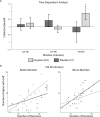Oxytocin Effect on Collective Decision Making: A Randomized Placebo Controlled Study
- PMID: 27070542
- PMCID: PMC4829266
- DOI: 10.1371/journal.pone.0153352
Oxytocin Effect on Collective Decision Making: A Randomized Placebo Controlled Study
Abstract
Collective decision making often benefits both the individuals and the group in a variety of contexts. However, for the group to be successful, individuals should be able to strike a balance between their level of competence and their influence on the collective decisions. The hormone oxytocin has been shown to promote trust, conformism and attention to social cues. We wondered if this hormone may increase participants' (unwarranted) reliance on their partners' opinion, resulting in a reduction in collective benefit by disturbing the balance between influence and competence. To test this hypothesis we employed a randomized double-blind placebo-controlled design in which male dyads self-administered intranasal oxytocin or placebo and then performed a visual search task together. Compared to placebo, collective benefit did not decrease under oxytocin. Using an exploratory time dependent analysis, we observed increase in collective benefit over time under oxytocin. Moreover, trial-by-trial analysis showed that under oxytocin the more competent member of each dyad was less likely to change his mind during disagreements, while the less competent member showed a greater willingness to change his mind and conform to the opinion of his more reliable partner. This role-dependent effect may be mediated by enhanced monitoring of own and other's performance level under oxytocin. Such enhanced social learning could improve the balance between influence and competence and lead to efficient and beneficial collaboration.
Conflict of interest statement
Figures




References
Publication types
MeSH terms
Substances
Grants and funding
LinkOut - more resources
Full Text Sources
Other Literature Sources

